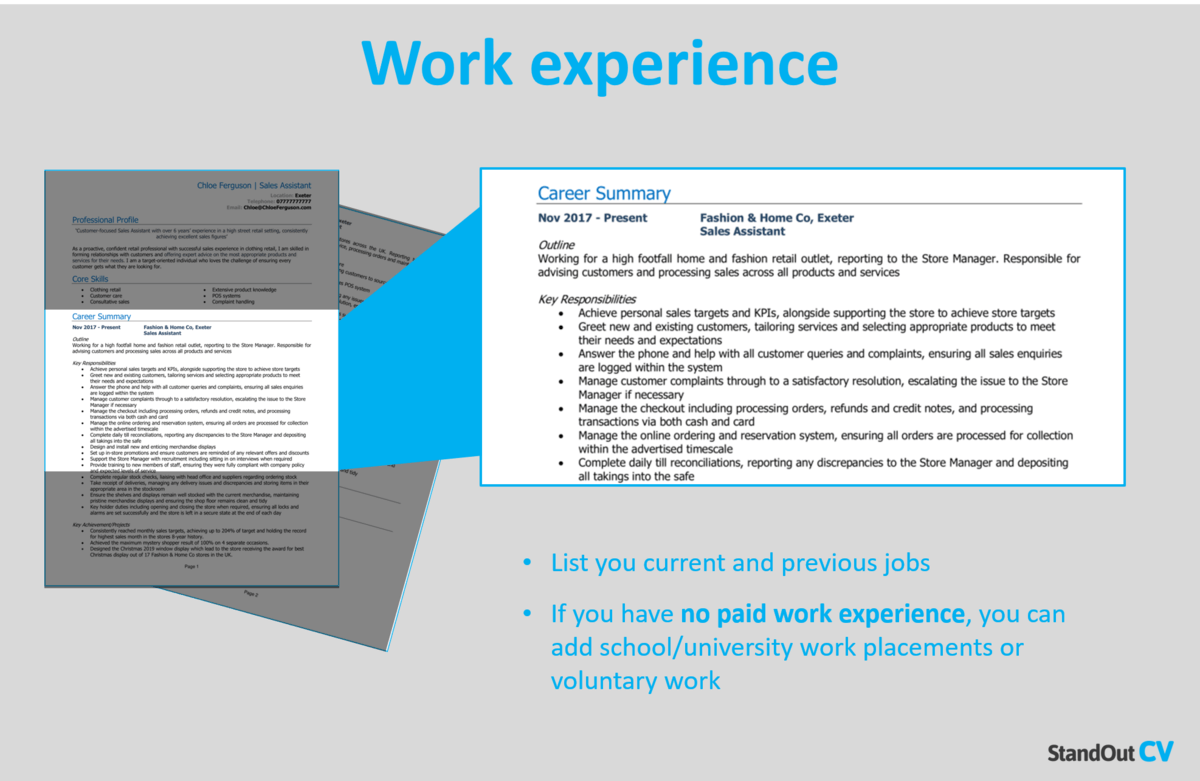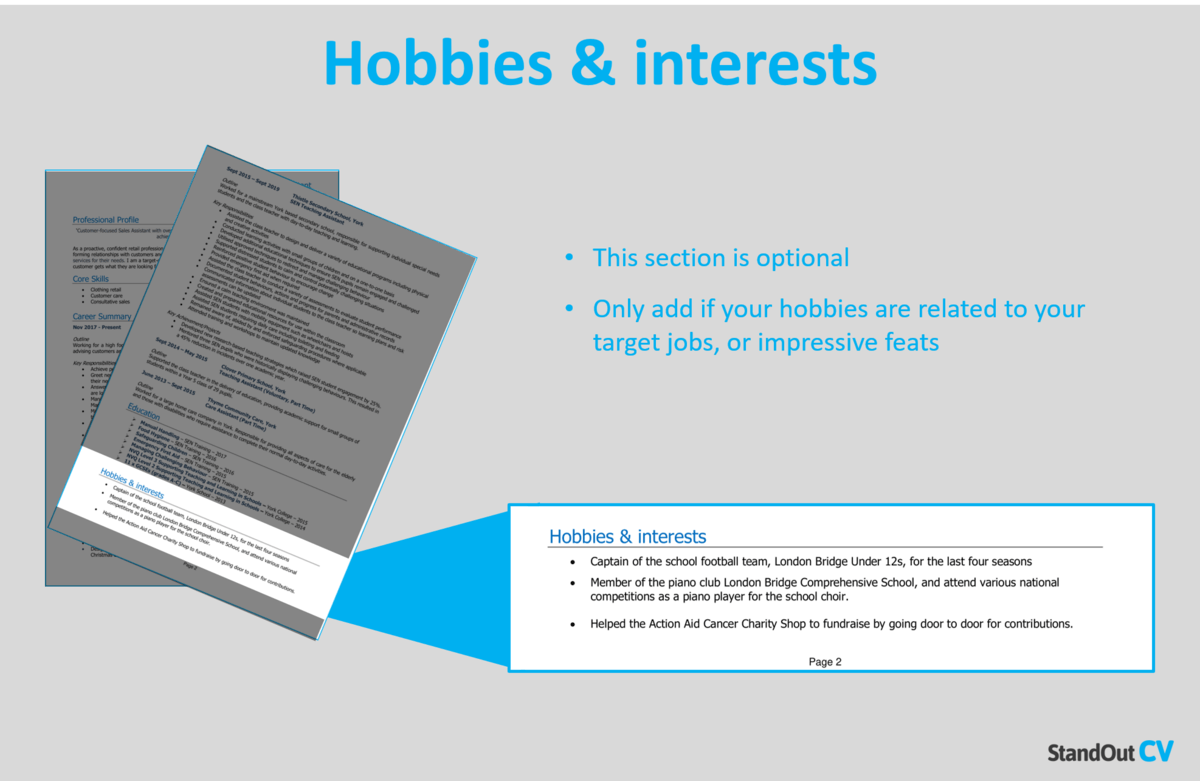Writing a CV can be difficult and time consuming.
But using a template can save you lots of time and effort, and it can ensure that you have a professional format that wows recruiters.
We created 10 interview-winning editable CV templates that you can download instantly for free (no login or email address required) in Microsoft Word or Google Docs.
Classic CV Template
Download options: Google Docs | Microsoft Word
The Classic CV Template offers a timeless and traditional design. It utilises standard fonts, straightforward formatting, and clearly defined sections. Key areas include contact information, a professional profile, work history, education, and skills.
When to Use: Best for traditional sectors such as education, healthcare, and government roles. This template suits those who favour a professional and conventional layout.
Corporate CV Template
Download options: Google Docs | Microsoft Word
The editable Corporate CV Template presents a neat, professional design focused on clarity and organisation. It features a conservative colour palette, standard fonts, and well-organised sections for contact details, a CV profile, work history, education, and skills.
When to Use: Ideal for corporate settings such as finance, consulting, and large organisations. It’s perfect for candidates aiming to project professionalism and dependability.
Sleek CV Template
Download options: Google Docs | Microsoft Word
The Sleek CV Template is modern and stylish, with a minimalist approach that prioritises simplicity and elegance. It features clean lines, generous white space, and a streamlined format. Key sections include contact information, a sleek profile, work history, education, skills, and possibly additional sections like languages or interests.
When to Use: Ideal for tech-savvy professionals and contemporary industries such as tech startups, digital marketing, and innovative companies. This template is great for those wanting a modern and polished appearance.


Modern CV Template
Download options: Google Docs | Microsoft Word
The Modern CV Template offers a sleek, contemporary design with stylish fonts and subtle colour highlights. It’s designed to grab attention without being overwhelming. Sections include contact details, a profile, work history, education, skills, and additional sections like projects or languages.
When to Use: Best for creative roles, marketing, design, or startups. It’s excellent for applicants who want to blend professionalism with modern aesthetics.
Exec CV Template
Download options: Google Docs | Microsoft Word
The Exec CV Template is designed for senior professionals and executives. It features a sophisticated, polished design focusing on accomplishments and leadership roles. Sections include contact details, an executive summary, key achievements, professional experience, education, and additional areas like board memberships or publications.
When to Use: Best for high-level positions such as CEOs, directors, and other executive roles. It’s perfect for showcasing extensive experience and significant accomplishments professionally.
Tech CV Template
Download options: Google Docs | Microsoft Word
The Tech CV Template is crafted for IT and technical professionals. It features a contemporary design with sections for technical skills, projects, and certifications, alongside the usual contact information, Cv profile, work history, and education. It often includes a section for programming languages or tools.
When to Use: Ideal for IT, software development, engineering, and other tech-related fields. It’s perfect for showcasing technical skills and project experience in a clean, organised manner.
Creative CV Template
Download options: Google Docs | Microsoft Word
The Creative CV Template stands out with its unique, visually engaging design. It often uses bold colours, modern fonts, and creative layouts. Key sections include contact information, a creative profile, work history, education, skills, and a portfolio or projects section.
When to Use: Perfect for roles in the arts, design, advertising, and media. This template is great for applicants who want to showcase their creativity and innovative thinking.


Elegant CV Template
Download options: Google Docs | Microsoft Word
The Elegant CV Template combines simplicity with a touch of sophistication. It uses elegant fonts and a balanced layout to create a CV that is both professional and stylish. Key sections include contact details, a CV profile, work history, education, skills, and possibly a section for awards or achievements.
When to Use: Ideal for roles in fashion, hospitality, event planning, and other industries where style and presentation are important. It’s perfect for candidates wanting to present themselves as polished and refined.
Clean CV Template
Download options: Google Docs | Microsoft Word
The Clean CV Template is known for its neat layout and ample white space. It uses a simple font and structured format that makes it easy to read. Key sections include contact information, profile, work history, education, and skills, with optional sections for certifications or hobbies.
When to Use: Suitable for almost any industry, especially those where clarity and organisation are essential. Ideal for applicants seeking a polished and professional look.
Simple CV Template
Download options: Google Docs | Microsoft Word
The Simple CV Template is straightforward and no-nonsense. It features a clean, minimalist design that focuses on clear text and logical formatting. This template usually includes sections for contact information, a profile, work history, education, and skills.
When to Use: Ideal for traditional sectors such as finance, law, and administration. It’s perfect for those who prefer a professional and uncluttered design.
More Google Docs CV templates | More Microsoft Word CV templates
How to download your free CV template
Once you’ve chose the perfect CV template for your job-type and experience level, it’s time to download and start editing.
You can download in either Microsoft Word or Google Docs – here’s how to do both.
- Microsoft Word – Simply download the document by clicking “Microsoft Word” from download options, open it up and start editing.
- Google Docs – Firstly you will need an active Google Drive account to use Google docs. Once you have one, click the “Google Docs” option from the download options, and you will be given the option to “make a copy” of the template. Click this button and it will create a copy of the template in your Google Drive, which you can edit – it will automatically save as you work on it.
How to fill out your CV template
Once you’ve downloaded your CV template, here are some tips for filling out each section, to ensure you create a wining CV and get maximum results in the job market.
CV Profile
Your CV profile is your chance to make a fantastic first impression, so make it count!
Think of it as a snapshot of who you are as a professional. Start with a brief introduction, highlighting your key strengths and career goals. Keep it concise, about 3-4 sentences, focusing on your most impressive achievements and what you bring to the table.
Use this section to convey your enthusiasm and passion for the field you’re in. For example, if you’re a marketing professional, mention your experience in creating successful campaigns and your knack for analytics.
Remember, this is not the place for buzzwords or fluff; be genuine and specific.
Tailor your profile to the job you’re applying for, showing that you’re the perfect fit for the role. Think of it as your personal pitch – make it engaging and memorable!


Work Experience
The work experience section is the core of your CV. Start by listing your most recent job and work backwards. For each position, include your job title, company name, location, and dates of employment.
Use bullet points to highlight your key responsibilities and achievements in each role. Focus on accomplishments that demonstrate your skills and impact – numbers are particularly powerful here. For instance, instead of saying “managed a team,” you could say “led a team of 10, improving project turnaround time by 30%.”
Be specific about your contributions and avoid generic statements. Tailor this section to the job you’re applying for, emphasising experiences that are most relevant. Use action verbs like “developed,” “implemented,” and “achieved” to describe your duties. This is your opportunity to show potential employers what you’ve accomplished and how you’ve added value in your previous roles.
Education
In the education section, detail your academic background starting with your most recent qualifications (GCSEs, A levels, degree etc.) In each entry, include the name of the institution, its location, the qualification you earned, and date achieved. If you’re a recent school leaver or graduate, you might also want to include relevant coursework, honours, or any other details.
If you have any certifications or additional training relevant to the job, list those as well. This section is particularly important if you’re early in your career and don’t have much work experience yet. However, even for seasoned professionals, showcasing continuous learning and relevant qualifications can strengthen your application. Make sure to keep it concise and relevant to the position you’re applying for.
Additional info (e.g. hobbies)
Including hobbies in your CV can be a great way to showcase your personality and interests, but only if they add value to your application. Choose hobbies that are relevant to the job or that demonstrate desirable qualities like teamwork, leadership, or creativity. For example, if you’re applying for a role in a creative industry, mentioning your interest in photography or graphic design can be beneficial.
If you’re in a team-oriented field, highlighting your involvement in team sports or community projects can be impressive. Avoid generic hobbies like “watching TV” or anything too personal. Instead, focus on activities that reflect skills or traits relevant to the job. Keep this section brief and to the point. It’s an opportunity to show a bit of your human side and potentially create a connection with your potential employer.

















